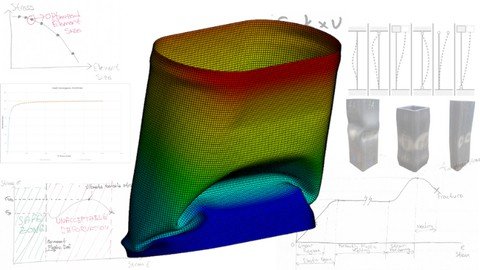
Last updated 1/2022
MP4 | Video: h264, 1280×720 | Audio: AAC, 44.1 KHz
Language: English | Size: 1.11 GB | Duration: 2h 28m
Linear and Nonlinear Buckling Method
What you’ll learn
Linear Buckling
Non-Linear Based Eigenvalue Buckling
Non-Linear Buckling
Newton-Raphson Method
Arc-Length Method
Post Buckling
Design Based on Buckling
Requirements
Fundamentals of Ansys Workbench
Fundamentals of Static Structural
Description
— Check My Website (importfea) —We are going to examine the topics of linear and nonlinear buckling. Since I have already prepared an introductory course for Ansys, we are going to focus only on the topic of buckling. In the course, we are going to see linear buckling, nonlinear buckling, post-buckling, and arc-length method. Version 2021R1 was used in the tutorial. We can gather the tutorial under 4 topics as linear buckling, nonlinear based eigenvalue buckling, nonlinear buckling, and post-buckling. The tutorial only includes the 4 main topics. In the first topic, we are going to focus on the questions of what is buckling and why is it important. Then, we are going to examine the topic of eigenvalue buckling. We are going to be learning the formulations and calculations for the critical load. We are also going to check the advantages and disadvantages of linear buckling and be learning why we need nonlinear buckling analysis. We are going to examine how to design based on buckling taking advantage of fast computing time in linear buckling. In the second topic, we are going to increase the accuracy with nonlinear-based linear buckling analysis. We are going to perform a nonlinear static analysis and, eigenvalue buckling analysis based on the results of nonlinear static analysis. Since the formulation and calculations for critical load are going to be changed, we are going to learn the formulations again. In the third topic, we are going to introduce nonlinear buckling analysis. Since nonlinear buckling analysis requires more experience and more computing time, it is going to be harder if we compared the linear buckling analysis. Firstly, we are going to learn nonlinear settings and then learn how to perform nonlinear buckling analysis. We are going to discuss the convergence problems. We are going to learn how to find critical load from the results of nonlinear buckling analysis. In the last topic, we are going to examine the behavior after buckling that we can’t capture on nonlinear buckling analysis. At the commencement of the buckling, nonlinear buckling analysis start to divergence and can’t solve the model. After the commencement of the buckling, we are going to learn how to capture the buckling behavior by using stabilization settings. In addition, we are going to learn how to use the Arc-Length method which is much more effective than the Newton-Raphson method, and learn how to use the command in Mechanical. Best Regards,
Overview
Section 1: Giriş
Lecture 1 Introduction to Buckling
Lecture 2 Linear Buckling
Lecture 3 Eigenvalue Buckling
Lecture 4 Linear Buckling Example – 1
Lecture 5 Linear Buckling Example – 2
Section 2: Nonlinear Based Linear Buckling
Lecture 6 Introduction to Nonlinear Based Buckling
Lecture 7 Nonlinear Based Linear Buckling Example
Section 3: Nonlinear Buckling
Lecture 8 Introduction to Nonlinear Buckling
Lecture 9 Nonlinear Buckling Example Part-1
Lecture 10 Nonlinear Buckling Example Part-2
Section 4: Post Buckling
Lecture 11 Introduction to Post Buckling
Lecture 12 Post Buckling Example
Section 5: Arc-Length Method
Lecture 13 Arc-Length Method
Section 6: Bonus Content – What’s Next?
Lecture 14 Fundamentals of Ansys
Mechanical Engineers or Students,Structural Engineers or Students,Mechatronic Engineers or Students,Metallurgy and Materials Engineers or Students,Everyone who Interested in Finite Element Method,Everyone who Interested in Buckling
Password/解压密码www.tbtos.com
转载请注明:0daytown » Ansys – Linear And Nonlinear Buckling Applications